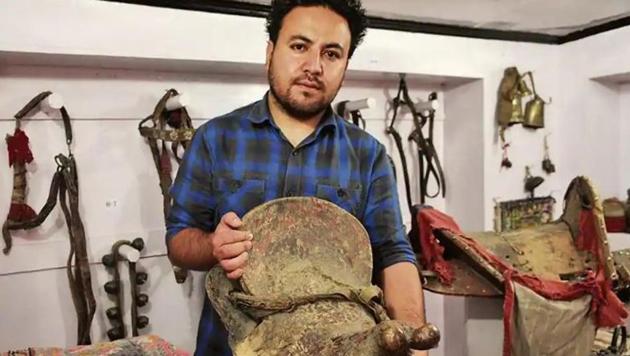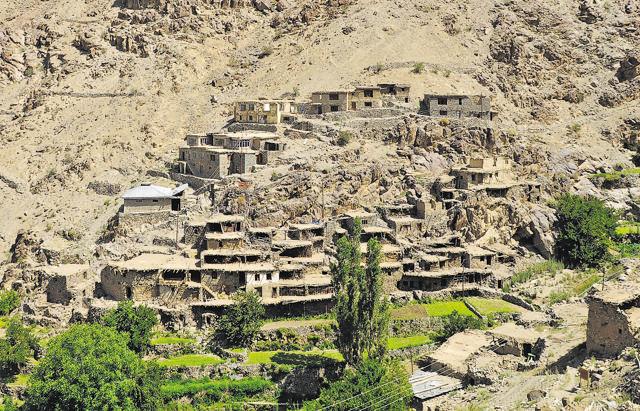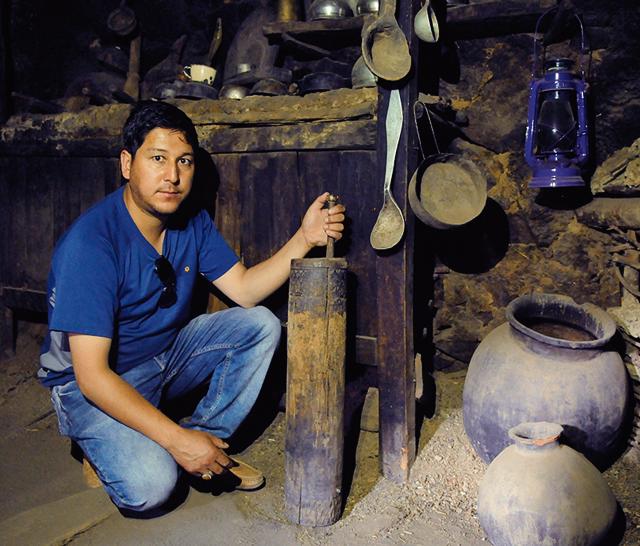Personal past: How families and communities in India are setting up niche museums
Family or community-run museums are important because they preserve a range of micro historical, cultural and political identities
Ajaz Hussain Munshi is a consummate storyteller. In the one-horse town of Kargil, Jammu and Kashmir, he is the go-to guy if you want to know about the border town’s rich history, its unremarkable present, and the fiercely fought war with Pakistan in 1999.

Ajaz, however, comes into his own when he steps into his family-run museum, which was set up in 2004 in the memory of his grandfather, Munshi Aziz Bhat, one of the leading traders of the Silk Road in the 20th century. The 54-year-old social activist is the curator and his brother Gulzar Hussain Munshi the director of the Munshi Aziz Bhat Museum of Central Asian And Kargil Trade Artifacts, a modest three-room repository, located at their home that has a sweeping view of the mountain town and the glacier-fed Suru river that runs along it.
While government-run museums such as the British Museum in London and Dr Bhau Daji Lad City Museum in Mumbai are naturally in another league altogether, family or community-run museums are important because they preserve a range of micro historical, cultural and political identities. “They [community and family-run museums] preserve material culture – objects and architecture that surround people – from getting lost,” explains art historian and independent curator Latika Gupta. “They also serve to make visible histories that don’t find place in mainstream national narratives, which construct a country’s history in a way that often leaves out entire regions and their layered histories”. Gupta was involved in the re-curation of the Munshi Aziz Bhat Museum, under the aegis of a fellowship from Bangalore-based India Foundation for the Arts (IFA), and the INLAKS Foundation. “Niche museums also help artists and curators to work with materials they would not usually have access to,” says Arundhati Ghosh, executive director, IFA.
Other examples of such bespoke cultural repositories include the Museum of Innocence in Istanbul, Turkey, which evocatively captures the everyday life and culture of the city, the Museum of Things in Berlin, Germany, which chronicles the product culture of 20th and 21st century, and a range of environmental and transportation museums in the US.

Closer home, there is the Anokhi Museum of Hand Printing in Jaipur, Rajasthan, and the Living and Learning Design Centre, Kutch, Gujarat. While the former preserves the dying art of block printing, the latter focuses on the preservation, revitalisation and promotion of the craft heritage of Kutch.
In Kolkata, West Bengal, economist, writer, and musician Rongili Biswas has set up a museum at her house in the memory of her father, Hemanga Biswas, political activist and member of the Indian People’s Theatre Association. “His ideals and politics are relevant to today’s India... I am also finishing a film on the peace mission of 1960 that he undertook through riot-affected Assam. At a time when the National Register of Citizens is being debated, his work and the journey and the museum are reminders that peace is possible even in troubled times,” says Biswas. “Ours is a small museum… a personal space. But there is interest. We do get visitors, especially those interested in music. Cinematographers take a lot of interest in his notes and musical instruments”.
STORY OF THE ROAD
The story of Kargil’s Munshi Aziz Bhat Museum is particularly interesting because the Silk Route is the backbone of the institution’s 3,500-plus collection. The Silk Route comprised ancient terrestrial and maritime trade routes that connected the East and the West. Though silk was the major item exported from China (hence the name), many other daily and luxury goods were also traded on this route. But “it was not only goods that flowed along the arteries [of the Silk Route] that linked the Pacific, Central Asia, India, the Persian Gulf and the Mediterranean in antiquity; so did ideas,” writes historian Peter Frankopan in his very engaging book, The Silk Roads. Among the most powerful ideas that spread via this route were “those that concerned the divine”: Hinduism, Jainism, Buddhism; Zorastrianism, Judiasm, Christianity and Islam.

Three trade arteries of this route passed through the Ladakh region, making Kargil equidistant from other trading centres such as Leh, Srinagar, Zanskar, and Baltistan (now in Pakistan), and therefore an important trading entreport, and its bazaar a commercial hub where commodities, ranging from silk to slaves, were transported, traded and taxed.
Munshi Aziz Bhat started trading in 1915. After a few years, he diversified his business by building a sarai (inn) for merchants at Kargil’s Caravan Bazaar. The trade collapsed after the Partition of India and the closing down of borders in 1947, forcing the businessman to shut down the sarai. The mercantile and cultural artifacts that are on display at the Munshi Aziz Bhat museum were discovered accidentally from this inn.
IDENTITY MATTERS
Despite being an important cultural and trade contact point, Kargil has no state-run museum to showcase the town’s rich past. But, thanks to the efforts of the Munshi family, there is now one more museum. The Museum of Memories at Hunderman Village, around 10 kilometers from Kargil, is at one of the unlikeliest of locations: along the India-Pakistan border. While the museum is managed by a few local families of Hunderman, the Munshi family helped them to set it up, curate the traditional items and popularise it.
The repository’s setting is one of the best in India: From the mountain road snaking around the hill opposite the 200-year-old village, Hunderman’s old stone houses, which are home to two galleries, look like a giant honeycomb clinging onto a mountain face, with green fields, apricot trees and a brook in the front. The museum captures the difficult life story of a border population whose lives have been shaped by military events: They were a part of Pakistan (1949-71), then India after 1971, and caught in wars the two countries fought in 1965, 1971 and 1999. The objects on display comprise border identity cards, old coins and notes, arms and ammunition, traditional clothes and items of daily use.
Though such bespoke museums don’t always get curatorial and infrastructure support that mainstream museums get, it would be wrong to label them as amateur efforts. “They not only come from a solid understanding of what is valuable but also stoke certain kind of scholarship. These museums in Leh/Kargil are part of the larger trans-Himalayan culture,” says Abeer Gupta, director, Krishnakriti Foundation, Hyderabad. “These museums represent micro-identities and question flattened narratives about India-Pakistan/Buddhist-Muslim.”

Abeer, who has worked extensively in the Ladakh region, says that in the last 10 years he has seen many local families investing in family museums, due to a certain economic solvency brought about by tourism. It’s also heartening to note, he adds, that the locals are resisting offers from richer collectors to buy their family heirlooms and other items because the owners know that they “will lose not just agency over the items and also they [items/artifacts] may get lost among other things in larger museums”.
AN EXPENSIVE PURSUIT
A museum is an elaborate and expensive affair. To attract visitors, it needs funds, space, interactive exhibits, good research,and a digital strategy. In India, many of the 800 state-run museums find it difficult to meet these requirements due to lack of funds. In the latest budget, the Centre allocated ~80.60 crore to the ministry of culture for museums. This amount, say, experts, is hardly enough for management of the country’s cultural resources.
Unsurprisingly, the challenges before the niche ones are much more varied. For example, the Munshi Aziz Bhat museum’s collection of material objects has no intrinsic value. Its value lies in the cultural, economic, social and political contexts the objects were embedded in. The histories of the objects and that of the collection are what make this story unique. “[So] the challenge that lay before Latika [Gupta] was how would she frame the collection in such a way that it reflects both the history of the objects and that of the collection itself, and bring to the fore the important geographical location that Kargil occupied on the India-Pakistan border,” explains Suman Gopinath, programme officer, Archival and Museum Fellowships, IFA.

“We definitely need funds for maintenance, better display of artefacts, museum building, art shop but the state government has not listened to our pleas though we have offered to give land for a new museum,” says Ajaz Munshi. “We want people to know that there is a Kargil beyond the 1999 war. While museums in Zanskar and Leh have received support, we seem to be pariahs for the state”.
Hunderman’s Museum of Memories’ problems include lack of expert curatorial support, funds, regular supply of electricity and even community support. “I did not know that our traditional items would be of any interest … we don’t have that exposure, education. But when Ajaz bhai and his nephew Muzammil explained their importance to me, I realised their value,” says Mohammed Illyas Ansari, the heart and soul of the museum. Many of his neighbours, he says sadly, are still reluctant to part with their personal items for the museum.
The lack of footfalls is another mega challenge. In 2015, many of India’s government-run museums recorded fewer than 100,000 annual visitors. In comparison, the Louvre (Paris), drew 8.6 million that year. Experts say this is because Indians lack a museum-going culture since cultural histories are hardly taught in schools.

In this rather challenging situation, can family/community museums flourish? Engagement, says Latika Gupta, is key. “There are still museums which see large numbers of visitors such as the Dr Bhau Daji Lad Museum or the Chhatrapati Shivaji Maharaj Vastu Sangrahalaya in Mumbai. So when museums have excellent exhibitions and programmes, there are visitors,” she says. IFA’s Gopinath says that their fellowship wants to nudge the museums to open up their collections, make them spaces of research, “rather than mausoleums that nobody visits”.
Despite these stiff challenges, Deepthi Sasidharan, director, Eka Cultural Resources and Research, Delhi, is optimistic about the future of family/community-run museums in India. “Established museums may have the resources but many of them lack vision and outreach,” she says. “They are too process-driven, while community museums are passion driven.”
Thankfully, the people who run these niche and bespoke museums aren’t lacking in it.







